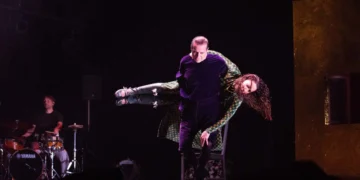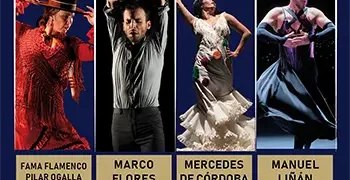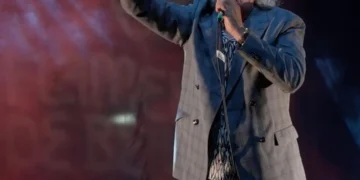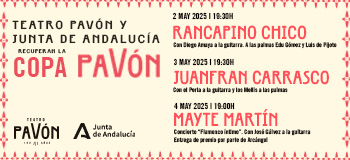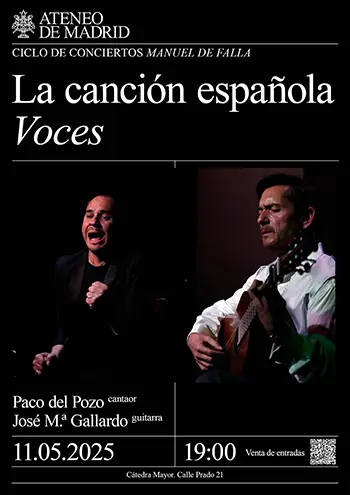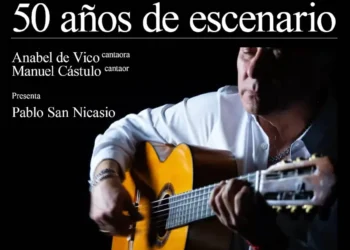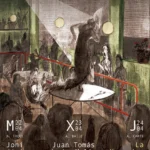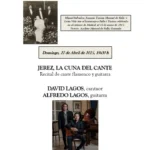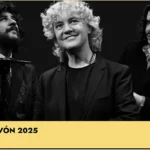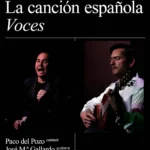|
ANDRÉS MARÍN, ‘EL ALBA DEL ÚLTIMO DÍA’ |
|
Photos: Ana Palma An excellent menu of shows was presented Thursday at the 2008 Festival de Jerez. Two interesting dance programs, and the charismatic singer Capullo de Jerez, idol of flamenco fans both in and out of Spain. Marco Vargas, Chloé Brûle Text: Estela Zatania The Sala la Compañía, an old church remodeled into a theater, is not the ideal place for dance presentations, much less a work conceived for open air. The original work of Marco Vargas and Chloé Brûle, “Cuando Uno Quiere y el Otro No”, was subtly modified for a closed space, gaining in coherence what it lost in vitality since we last saw it in Antequera last summer. Nevertheless, it continues to be a work which is well-conceived, beautiful and entertaining. There are only three people in the show, two of them, the starring couple, scarcely leave the stage at any moment, nor do they leave room for applause until the very end. The absence of “numbers” as such, adds to the magic. “Cuando Uno Quiere y el Otro No” reflects the fragile dynamic in sentimental relationships, the eternal cycle of love and unlove, via a clever mix of flamenco and contemporary dance. The young stars are solid professionals with good training, but their artistic rapport is the catalyst that makes everything come together. Juan José Amador, singing throughout with no guitar backup, does an admirable job in a role few singers would want or know how to manage. Andrés Marín
Andres’ dancing is hard to describe. He has created a unique image for himself: the fitted stretch pants, short hair slicked back, tensely calm countenance. He uses movements that are nearly robotic, and a subtle sense of humor is always near the surface. His dance is the perfect balance of precision without coldness, flamenco without corn, and constructive evolution. He surprises and fascinates, and there is always plenty of good cante with the exceptional voices of Segundo Falcón and José Valencia who provide a mini anthology that includes trilla and martinete, soleá de Triana, caña, a lovely malagueña with the two singers trading off lines, abandolao, cartagenera and levantica, tangos de Triana… The siguiriya danced on a raised platform is the perfect sum of its parts, and a jondo jewel. Antonio Coronel’s subtle percussion, Salvador Gutiérrez’ guitar, Francis Mannaert’s lighting and Yván Schreck’s audiovisual work are noteworthy…in other words, there are no weak links in the chain. This time, thanks to the intelligence, good taste and ability of Andrés Marín, the experiment gave good results.
Capullo de Jerez Text: Manuel Moraga I don’t know if it was because he was in his hometown, but, for the most part, Capullo was singing with more feeling than on recent occasions. It was that way from the beginning, taking the solea por bulería slower than he usually does. He proceeded to warm up his voice with a round of fandangos, but they came off rather shouted. He then went into martinetes and seemed to feel more at home. I think however he made the mistake of taking them a little too rushed, which adds nothing to these cantes, in fact quite the contrary, it dimishes them. With just a bit of calm, they would have come off much better. Next, it was pure Capullo with tango-rumba and bulerías. At such moments, I can’t help but feel a certain sense of dread thinking of the endless string of verses and more verses the man from Santiago tends to churn out, but this time, possibly due to that touch of warmth Capullo was expressing, it was not unbearable. There was a variety of forms and a certain equilibrium. Capullo wrapped himself in his rhythmic universe and had some excellent moments both in rumba and bulerías. He interpreted and gave meaning to the cantes with that incredibly mathematical sense of compás, and did not allow the artistic tension to flag. The bulerías just as easily included siguiriyas as granaína. In other words, the Capullo trademark closed out Thursday night with a good feeling.
|





 When you enter the theater and take your seat for “El Alba del Último Día”, you enter a hermetic world where time has another dimension, or perhaps even runs in reverse; it’s hard to situate yourself in this ambience born from the fertile imagination of Andrés Marín. The complicated libretto about the café cantante period adds little to the experience, so we shall put it to one side, because this perfect work, like all high art, speaks for itself. A postmodern aesthetic filtered through the clear vision of Marín, gives life to a surreal world where classic flamenco is the driving force.
When you enter the theater and take your seat for “El Alba del Último Día”, you enter a hermetic world where time has another dimension, or perhaps even runs in reverse; it’s hard to situate yourself in this ambience born from the fertile imagination of Andrés Marín. The complicated libretto about the café cantante period adds little to the experience, so we shall put it to one side, because this perfect work, like all high art, speaks for itself. A postmodern aesthetic filtered through the clear vision of Marín, gives life to a surreal world where classic flamenco is the driving force.
